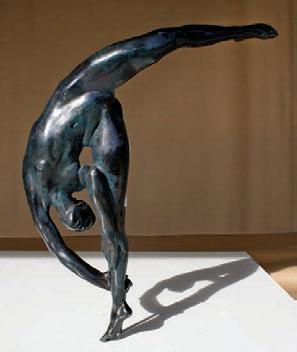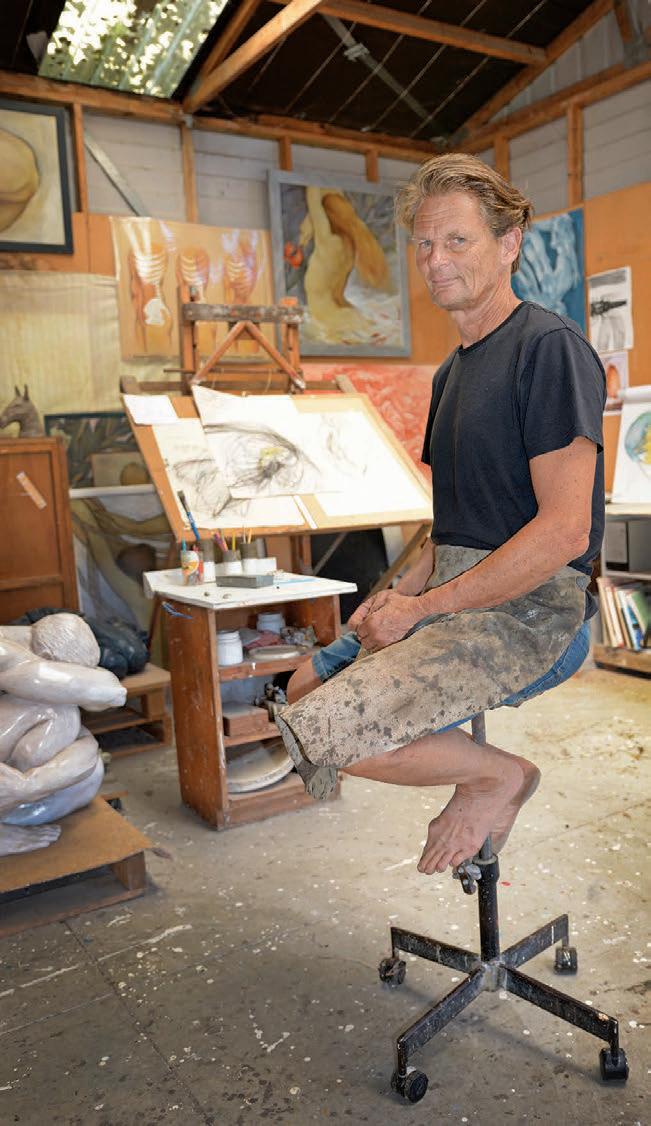
10 minute read
An interview with Brett Taylor
from Plenty March 2020
The work of Bay of Plenty artist Brett Taylor has a classical and yet very Kiwi aesthetic. His sculpture explores the human body and nature via cast bronze and glass – two particularly difficult to master art forms – and yet remain solidly grounded and real, seemingly drawn up from the earth around us. His work can be found everywhere from Taupō (where the seven-metre-tall ‘Heartland Taupō’ sculpture makes a commanding presence beside the Taupō Museum), to private collections in Washington and Hong Kong.
Originally from Auckland, Brett Taylor has made the Bay of Plenty his home for 18 years, with his current studio nestled on the cliffs overlooking the Matatā coast (and incidentally, the dunes of Ōtamarākau – see our history feature on page 60). Part workshop, part art gallery, part foundry, the studio shares the cliffs with an ancient pā site and an organic avocado orchard, and The Winsley Twins paid it a visit.
Advertisement
PLENTY Did you come from an artistic background?
BT Yes, very much so. My mother was one of the first students at Elam School of Fine Arts, there with people like Toss Woollaston, but in those days’ artists were considered to be the fringe dwellers of society. They probably still are, but we’ve managed to weasel our way into polite society a bit more in recent years! My mother was part of that crowd and at a very dynamic time in New Zealand art, but ultimately my mum chose another canvas – she had a family. But when I grew up there were always paper and glue and things like that around on the table, there were always things going on, so art just seemed a part of life. As opposed to something ‘other’ as it is for many Kiwis. PLENTY Did you follow in her footsteps and go to Elam?
BT No! I dropped out of school. In those days the school system never really related to right brain thinking – I think they do a bit better now – but in those days you had to fit into a very, very small box, and I wasn’t ready for that. But it’s not easy to stay in the art world, and in my early years I used to pump gas in order to be able to keep doing my art. I used to work night shifts so that I could spend the day doing art; as long as I had bread and butter, I could keep doing what I wanted, which was drawing and painting.
Eventually I studied graphic arts at Auckland Technical Institute, but I studied design, which wasn’t really right for me, and then eventually went back to Auckland Arts Academy a few years later. I was there literally at the time when they said, “Throw away your pencils, it’s all going to be computers from now on,” which is unfortunate because that crams you into a certain genre of work. And my ‘analogue’ approach has remained with me to this day – I like tactile things and I like drawing, I like clay. I think a part of the reason is that there are so many more surprises in those mediums – and as artists, or humans for that matter, we’re always in pursuit of the things we don’t understand. So those surprises that come with tactile things, the mistakes, the wrong turns, the effects of gravity! All those are invaluable. They’re gifts from the process.”
INTERVIEW THE WINSLEY TWINS WORDS & PHOTOGRAPHY ANDY TAYLOR IMAGES SUPPLIED
Below: ‘DON’T THINGS LOOK DIFFERENT FROM ABOVE‘ Stoneware

BT No, initially I was attracted to drawing. I loved drawing, and still do; everything I do starts at the drawing board. But there was always a three-dimensional aspect to it – I was virtually carving things into paper – and I suddenly realised my place was in 3D. Paintings have depth of course, because you can portray perspective, but a painting can never be the same as an actual object. At the same time, I realised that it was really hard to find a point of difference in painting. A friend, Ron Hall, who is an award-winning artist in his own right, told me that out the back in any gallery you can find stacks and stacks of paintings leaning against the wall, because it is so hard to find a real point of difference. That’s true I suppose for sculpture too, but to a much lesser degree; once you get up into four or five kilos of glass or more of bronze then things start to happen that can never happen on a canvas.


PLENTY Transitioning from painting to sculpture is quite a shift – in both mind set and skill set.
BT Yeah! And it’s been a tough learning curve, and there were many, many failures. The thing with glass is that you can only cast it twice – after that, the molecular structure changes and then it’ll start cracking. It might last a couple of weeks or a couple of months, but it will eventually just fall apart – which is not something you want to happen when you’ve sold it and it’s on someone’s mantelpiece! So, you only get two shots at getting it right, and if you don’t get it right you have to start all over again. So, the mistakes can be ‘gifts from the process’ but they can also be . . . well, y’know. I was lucky enough to study with George Andrews (see Plenty 10). And after that I started buying equipment and welding up stuff and George would come over and help out and we’d go riding together. And like I say it’s been a learning curve, but we got there.
The thing with sculpture is that it’s pretty hard yakka. You just have to sit down, make yourself comfortable and push your way through. Working with bronze is all pyrotechnics and fireworks on a casting day, but before you get there you have to spend hours, days working in the wax. And wax is really horrible stuff to work with, especially on a hot day – which is everyday here in summer!
PLENTY.CO.NZ // POUTŪ-TE-RANGI 2020 Above: One of Brett’s many drawings
Left: ‘ANALOGUE CURVE’ Bronze

BT My mother had a place at Rotoiti – from way back, before the war! We used to come down from Auckland and spend time there, but I was pretty young and though I loved it, it wasn’t until I was talking to people at her funeral that I reconnected. Some of the stories from there, from Hinehopu, were about how there were still people netting freshwater crayfish – koura – in canoes, and that was only a generation ago. So that kind of reignited the great graphic picture I had from my mother, and about that time Auckland was getting just way too busy for me.
I did well in Auckland with portraiture. But in Auckland you have to get to know the right people, and I just didn’t handle the pressure of that city at all! I was young and going through lots of shit and getting into trouble and was basically just way too interested in entertaining myself instead of thinking about any kind of future. I was always drawing and always painting though, and it dawned on me that this was the most important thing – so I just decided that I was off to the lake. That was my late twenties and all I did for the next few years was paint and mow lawns! ‘EVE’ Stoneware

PLENTY You were never tempted to pack it in and get a real job?
BT No. Not really. I think everyone has a creative side to them, and we’re all called to do something, but most of us have to earn our crust, feed our families. I’ve been fortunate enough to be able to handle doing pretty shitty work to earn my crust while I kept slogging away at drawing. It’s always tempting to improve the way you make a living but that can start to take precedence, and I was always quite capable of going out and just getting any kind of job that I had to – dishwashing, courier driving, pumping gas – whatever was going at the time. But I never felt a sense of being misplaced. Dishwashing took me around the world mate! And about 25 years ago that brought me to a place where I didn’t have to do those jobs, my art could support me. Which is a real great place to be.

2020 SUMMER ARTS FESTIVAL
We are excited to be presenting a wide range of amazing arts events for the community this season - all organised by local people, and taking place in the Eastern Bay of Plenty.
Whether you’re keen to experience performing arts, see exceptional visual arts, get to know local creatives, absorb international art perspectives, or just have a day out with the family, there’s something for everyone in the mix...


Mon–Fri 9 am - 5 pm, Sat - Sun 10 am - 2 pm. Te Kōputu Exhibition Centre, Whakatāne Cost: Free Presented by Arts Whakatāne and exhibition partner District Council, this national award aims to support and promote artists by presenting 3D work across a range of disciplines.
MONDAY 9 MARCH
ORGAN RECITAL BY JOHN WELLS
7.30pm. Lounge at Whakatāne Little Theatre. Cost: adults $30, concessions $25 and children $5. An amazing musician - playing contemporary and classical pieces. A concert not to be missed. Hosted by Music Whakatāne.
FRIDAY 20 MARCH
BRENDAN DOOLEY MAGICIAN
5.30 pm. Mayhem! – Kids Show 7.30 pm Cheeky, Quirky & Classy – Adult/Family Show Gateway Theatre. Cost: $20 Adults, $30 Family and $15 Concessions. Book: The Good Life, Whakatāne. SATURDAY 21 MARCH
MMCA “THE ART OF LOOKING” SARAH HUDSON
10:30 - 11:30am. Te Kōputu Exhibition Centre, Whakatāne. Cost: Free A kid-focused interactive tour of the dynamic, exciting and sometimes confusing world of contemporary art.
SATURDAY 21 MARCH
TAIKO DRUMMING
6.30 pm. Liberty Centre. Gold coin donation Experience Taiko drumming at it’s best. The night will include a performance from your local drumming group, Kagutai. WaiTaiko from Hamilton and a performance from a professional drummer, Kenji Furutate from Japan. This is a unique cultural experience and one not to be missed. MONDAY 30 MARCH

CENTRAL TO THE SOUL - MOVIE FUNDRAISER
5.15pm for drinks and nibbles, 6.15pm for Movie. Whakamax. $20 tickets at Good Life This is a fundraiser for Arts Whakatāne to help with organising and financing arts events for the Whakatāne community.
April
SATURDAY 4 APRIL
MMCA 3D TALK
11am. Te Kōputu Exhibition Centre, Whakatāne. Cost: Free Deborah Rundle 2018 3D Award major winner and preselection judge 2020. Deborah will share her views of the present Molly Morpeth Canaday Award 3D exhibition as a preselection judge.
SUNDAY 26 APRIL
AROHA STRING QUARTET
4pm. Church of St George & St John. Gold Coin Donation Founded in 2004, this versatile Wellington-based quartet is known for its passionate musicality, impressive technique, and multicultural innovation. It is committed to presenting string quartet works from western classical and avant-garde repertoire to traditional Chinese folk music. Hosted by Music Whakatāne.
ARTS ON TOUR NEW ZEALAND PRESENTS the ULTIMATE family-friendly Show! “A new generation of talent already snapping at theheels of established acts.”
Image from 2020 3D award Art work entry by Monique Lacey
2020 Molly Morpeth Canaday Award 3D
exhibition Open for viewing 16 February - 12 April 2020
public programmes 11am Saturday 21 March Gallery Talk - The art of looking, Sarah Hudson. 11am Saturday 4 April Gallery Talk - Deborah Rundle, past major winner 2018 MMCA 3D Award and Pre-selection judge 2020. March 24 - Peoples Choice Award Announcement
FRIDAY 20 MARCH 5:30PM & 7:30PM WHAKATANE GATEWAY THEATRE Adults $20; Family 30; Concessions $15 Book: The Good Life, The Strand, Whakatane





